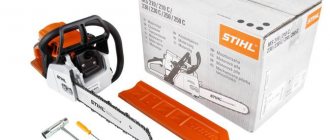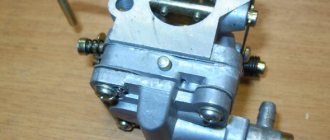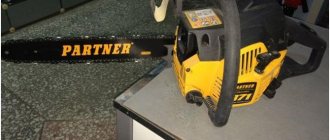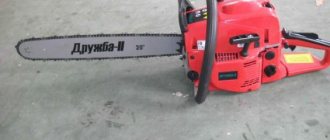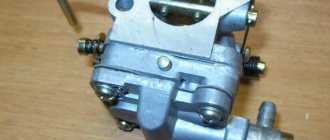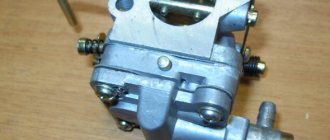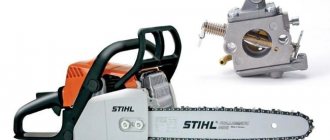When operating a gasoline saw, the chain is subjected to significant heating, and therefore requires mandatory lubrication. The oil is distributed throughout the saw set, thereby preventing premature wear.
But sometimes the chainsaw chain lubrication device may fail, causing the following symptoms to appear:
- chain lubrication is leaking;
- a small amount of oil is supplied due to a breakdown of the pump or other elements;
- chain stretching or excessive heating.
Such signs indicate that there is no lubricant supplied to the chain of the gasoline saw or there are any breakdowns.
Chainsaw chain lubrication system
To supply oil to lubricate the chainsaw chain, the tool uses a special pump, which delivers lubricant to the saw bar in a dosed manner, depending on the number of engine revolutions.
The system uses oil to lubricate the chainsaw chain, which has increased adhesive properties; this is necessary for uniform distribution of oil along the entire perimeter of the bar and retention on it even at high rotation speeds of the chain. Let's take a closer look at the oil supply system implemented in modern chainsaws.
Review of the Husqvarna 135 petrol chain saw
The Husqvarna 135 chainsaw is a household tool, indispensable in private households. When creating a chain saw, the equipment manufacturer took into account the wishes of its consumer, who uses previously released models, collecting all the best from previous modifications in one chainsaw. The purpose of the Husqvarna 135 household chainsaw is sawing logs and boards. tree pruning, etc.
The Husqvarna 135 chain saw is lightweight (4.4 kg without equipment) and compact in size. Two-stroke carburetor power plant with a capacity of 2.04 liters. With. equipped with the X-Torq system, which reduces fuel consumption by 20% and reduces the amount of harmful exhaust emitted by the chainsaw (the amount of toxins is reduced by up to 70%). Two-stage air purification allows you to increase the service life of removable filters. To make it easier to start petrol tools in any weather, the Smart Start easy start system was installed. The chainsaw is started using an inertial starter, the throttle control is semi-automatic. The unit is equipped with a universal improved Zama EL 41 carburetor, electronic ignition. A damping system is used to dampen vibrations that occur during operation. The chain is automatically lubricated.
To protect the owner of the equipment during operation from accidental rebound or chain breakage, the manufacturer provides a chain catcher and a chain brake. The chain tensioner is located on the side of the unit.
Specifications
| Type: | chainsaw |
| Design: | manual |
| Power, W: | 1500 W |
| Number of speeds: | 1 |
| Chain pitch: | 3/8 inch |
| Tire length, cm: | 40 cm |
| Engine capacity, cubic meters cm: | 40.9 cu. cm |
| Fuel tank capacity: | 0.37 l |
| Oil tank capacity: | 0.25 l |
| Functions and capabilities: | anti-vibration, chain brake |
| Noise level: | 114 dB |
| Weight: | 4.4 kg (without bar and chain) |
| Chain brake: | There is |
| Bar groove width: | 1.3 mm |
| Anti-vibration: | There is |
The cost of this unit on the domestic market varies between 13 thousand rubles.
Peculiarities
- household tools;
- light weight;
- two-stage air purification;
- improved Zama EL 41 carburetor;
- using a motor with the X-Torq system;
- easier starting of the chainsaw;
- damper anti-vibration system;
- semi-automatic throttle control;
- automatic supply of chain lubrication;
- high power (2 hp);
- maintainability;
- hand protection;
- environmental friendliness;
- chain brake;
- reliability;
- endurance;
- easy to get spare parts.
Lubrication system design
Depending on the brand of chainsaw, the parts of the lubrication system may vary slightly in design, but their total number and connection diagram remain the same.
The main components of the lubrication system are:
- an oil tank located, as a rule, in the engine crankcase.
- The filter element is installed in the tank.
- The oil line is a small diameter hose made of oil-resistant rubber.
- The heart of the system is the oil pump.
- The worm gear transmits force from the engine to the pump.
- The chainsaw tire can also be considered an element of the lubrication system, since it has special holes for supplying oil. By the way, the chain itself is involved in transporting oil and, accordingly, also has some elements designed specifically to provide lubrication.
Principle of operation
The main unit of the system is the pump. The principle of its operation is as follows. As engine speed increases, a gear mounted on the main shaft drives the pump shaft through a worm gear. In turn, the rotation of the shaft creates a certain pressure in the oil line, which forces the oil to move along it towards the tire.
The end of the oil channel is located at the point of contact of the tire with the tool housing, where there is a longitudinal groove into which, when installing the tire, its oil channel falls.
The groove is necessary to ensure the supply of oil to the bar, regardless of the degree of tension of the chainsaw chain. Simply put, no matter what position the tire is in at the time of operation, oil will get onto it through the groove.
Next, the lubrication process includes a chain, on the links of which, depending on the chain model, there is either a groove or a hole through which the oil is dispersed throughout the tire. As engine speed increases, the oil flow rate also increases.
Some models of chainsaws are equipped with pumps that additionally have capacity adjustment, and if necessary, the amount of oil supplied by the lubrication system can be increased or decreased.
This function is quite convenient, because it allows you to save money and not waste extra oil.
How does a chainsaw carburetor work?
Chainsaw carburetor Stihl MS 181 C BE
Chainsaw carburetors may differ in design. However, their basic elements and operating principle remain approximately the same.
Carburetor design:
- The basis
This is a wind tunnel, across which there is an air damper - with its help the intensity of the air supply is regulated.
This part is where the base tube narrows - here the air flow speed increases, i.e. air is always supplied to the carburetor under some pressure.
In this area, the fuel comes into contact with the air flow. Fuel enters the atomizer from the float chamber through a nozzle (dispenser).
- Float chamber
This is a container that allows you to keep the fuel mixture in a stable state.
Chainsaw carburetor design diagram
A chainsaw carburetor works according to the following principle:
- when the engine starts, the main damper opens and a stream of air is supplied into the air channel at a certain speed;
- the speed of the air flow, as well as the level of the float in the chamber, are regulated by the position of the damper, namely due to the difference in pressure in the float chamber and the air channel;
- fuel from the float chamber is sucked into the nozzle, and from there into the diffuser;
- passing through the diffuser, the air captures the fuel entering there;
- the resulting mixture is fed into the cylinder cavities through the intake channels.
The principle of operation of a chainsaw carburetor
The pressure in the float chamber is approximately equal to atmospheric pressure, but a vacuum occurs in the air channels of the carburetor when the chainsaw engine starts. Opening the damper increases the air supply intensity. As a result, more fuel enters the carburetor, and the number of engine revolutions increases.
Lubrication system malfunctions and how to fix them
The main malfunctions of the oil supply system on a chainsaw can be divided into two main types: these are general malfunctions inherent in all chainsaws and individual ones, which may vary depending on the type of pump and worm gear installed on a particular model. Let's begin to understand the faults in order.
Operating a chainsaw without lubricating the chainsaw chain is prohibited. This has a detrimental effect on the bar, drive sprocket and chain, and can result in significant repair costs.
Signs of a malfunction of the lubrication system, checking its performance
- The chainsaw chain is dry and has a pale tint without shine.
- The chain stretches relatively quickly.
- The tire is very hot and may even partially melt the paint.
- The oil from the tank is practically not reduced.
- Reduced cutting efficiency on a sharp chain
All these signs indicate that the lubrication process is not proceeding properly. In order to check the oil supply to the lubrication system, you need to remove the side tire of the chainsaw and start it. Next, you need to slightly increase the speed while observing the end of the oil line. If oil comes in, most likely the amount is not enough for normal lubrication and you need to clean or replace the filter and, if possible, adjust the flow. If it does not, the problem is more serious and requires further diagnosis.
There is a way to check the oil supply without removing the tires. To do this, you need to point the end of the bar towards, for example, a freshly cut piece of wood from the side of the cut and increase the speed as much as possible, while trying to keep the end of the bar at a distance of no more than 10 cm from the block. If oil spots begin to appear on its surface, it means the oil is being supplied.
Troubleshooting
Once it has been determined that oil is not being supplied, further diagnosis is only possible if the oil system is completely removed. Of course, in some situations replacing the filter helps, but this is very rare.
Access to the oil pump of some models of saws is possible only after complete disassembly; therefore, without having the skills to repair gas-powered tools, it is better to entrust repairs to professionals.
Most common faults
- Broken oil hose. It can sometimes be detected by visual inspection. The problem is solved by replacing the faulty part.
- There is no thread on the oil pump shaft; replacing it will help.
- A defective thread on the pump drive gear can be similarly solved by installing a new part.
- Lack of main shaft corkscrew (relevant for some instrument models, for example, Homelite). You can fix it by installing a nail of a suitable diameter instead of the original corkscrew, cutting it to the required length.
- Blockage in the line. Can be removed by blowing with compressed air or mechanically, using a wire of a suitable diameter.
- Filter element clogged.
- The Stihl MS 180 tool, whose pump is not dismountable, often gets clogged. You can try to wash it in clean gasoline, if that doesn’t help, replace it.
- In Chinese chainsaws (Gypsy), it very often cuts off the grooves on the main gear, through which the force from the sprocket is transmitted to it.
Individual malfunction of the Stihl MS 180 lubrication system
Due to the fact that the Stihl MS 180 is one of the most common models of chainsaws, I would like to dwell in more detail on one fault inherent only to it and describe a method for eliminating it without replacing parts.
Quite often, on the Shtil MS 180 chainsaw, depressurization of the oil line is observed in the place where the oil line coming from the tank is installed in the saw body. The malfunction can be determined by the characteristic lubricant leaks on the bottom of the tool.
To eliminate the problem, you need to remove the chainsaw handle, remove the hose from the mounting hole, clean and degrease. After all these manipulations, apply sealant to the hose seat and install it into the chainsaw body.
You can learn more about troubleshooting and complete diagnostics of the lubrication system of the Stihl chainsaw by watching a video that shows the step-by-step process of disassembling and repairing the lubrication system.
Proprietary technologies
In addition to the shock-absorbing system, to which the Swedes gave their own name LowWib, as well as combined control of the air damper and ignition switch, the Mark II line has two proprietary technological solutions implemented by Huskvarna on most saws:
Air Injection System. A patented feature of the Swedish company's chainsaws. In simple terms, the flywheel impeller and the shape of the housing are designed in such a way that large polluting particles are thrown onto the walls of the inner surface due to centrifugal forces. What is left goes to the filter and is retained there. Since it is large chips and sawdust that tend to get stuck in felt, pierce and tear it, words about the lifespan of the filter element do not seem like mere chatter from marketers. On the Internet you can find videos of meticulous users who deliberately covered working saws with handfuls of sawdust when making comparisons. An autopsy showed that the Husqvarna filters were less clogged.
Husqvarna Chainsaw Chain Lubrication System
Operation the Husqvarna 137 chainsaw
I bought a Husqvarna 137 chainsaw. During operation, a question arose. Should chain oil and gasoline run out immediately? I ran out of oil quickly. I think this is incorrect. Could there be something wrong with the saw?
In the saw, oil should be used for two purposes. mix with gasoline (if this is provided for by the design) and lubricate the chain. Main expense. chain lubrication. Because if you cut intensively. then it will end faster. And if you don’t cut anything, but just gas it. then the gasoline will quickly run out. Do not leave the chainsaw idling, as when the engine is running, the oil supply automatically turns on to lubricate the bar and chain. You can use a special screw to regulate the oil supply to the tire. If the oil is thin, it may run out faster than gasoline.
I'm confused by the presence of a metallic sound in the Husqvarna 137 chainsaw, like a bearing or something else in the clutch area here and there, is this normal or does something need to be lubricated and tightened?
This is the clutch cup ringing while it is new and completely unsullied on the inside. Over time, a certain amount of adhering dust will appear there and the hum will end.
I saw that the tire had become an arc. I can't understand why this happened. I did not apply lateral forces. If you place the tire on a flat surface, then the middle is 2-3 mm away from the axle. I straightened it out in a vice slowly, it became even. I haven't tried sawing yet. Could this happen due to tire overheating? And it also began (when warmed up) to stall from time to time when pressing the gas.
The worst thing is if the hot chain is pulled tight, but is not immediately loosened after work. So the tire bent like an onion. The best case is if it was immediately deformed, but was only seen now. In the first case, serious engine repair cannot be avoided. deformation of the crankshaft toe, damaged bearings and their beds.
I bought a Husqvarna 137 saw, problems immediately appeared with the carburetor, tell me what can be done, are there any adjustments? Unstable at idle
and when you press the gas approximately halfway through, it seems to choke, and later it seems to be normal, but only at full speed.
How to recognize carburetor failures?
Operation diagram of a chainsaw carburetor
Carburetor settings may be affected by:
- lack of fixation of the adjusting screws;
Chainsaw adjustment screws
New CPG chainsaw Husqvarna 365
Chainsaw air filter with nylon insert
Any problems found should be corrected immediately. But how can you determine that the problem is in the carburetor? To do this, watch how your tool works.
Typical signs that the carburetor settings are off include:
- Unstable motor operation
As a rule, the reason for this is the use of the wrong (lean) fuel mixture.
- Excessive fuel consumption
It is expressed in an increased release of exhaust exhaust, which turns black. This means that fuel is not completely consumed, i.e. the mixture is oversaturated.
The carburetor is adjusted correctly - the saw starts the first time
- Arbitrary changes in engine power
May be associated with damage to the fastening of the adjusting screws or the protective cap.
- Increased fuel consumption accompanied by vibrations and pops
This indicates critical wear of the piston group, so adjusting the carburetor will only postpone major repairs for some time.
- Sneezing and engine jerking
This picture is observed when the carburetor channels are clogged or its filters are faulty. In this case, adjustment should be carried out only after thoroughly washing the unit.
Chainsaw fuel filter
Despite the fact that the carburetor is the most complex part of the engine, you should not be upset if you detect malfunctions in its operation. Instead, you need to arm yourself with some tools, a design diagram of the unit and sound logic.
Chainsaw carburetor being repaired
Oil does not flow to the chainsaw chain: causes and solutions
When the saw chain of a chainsaw moves in the groove of the bar due to friction, a large amount of heat is released. If oil does not flow to the chainsaw chain, it is necessary to stop work and take all measures to eliminate the malfunction of the lubrication system. The combination of heavy loads and overheating of the headset is accompanied by its accelerated wear and early failure.
- Without exception, all chainsaws and their electric analogues are equipped with systems of the same operating principle, through which the lubrication of the bar, saw chain and its drive parts is carried out.
- The standard composition of this device includes a reservoir from which chain oil is supplied to the inlet of a pump with a fixed or adjustable capacity.
- Next, the working fluid in a dosed amount enters the groove of the bar, in which it is evenly distributed by the shanks of the saw chain over the entire headset and the working surface of the drive sprocket crown.
Performance tires with a length of 400 mm or more are equipped with a driven sprocket. Periodic lubrication of the bearing is carried out individually, after 6-8 hours of operation.
Main problems with oil supply
When operating a chainsaw, two types of problems with the supply of lubrication to the chain can be observed:
- Insufficient oil flow, which can be caused by various reasons. If measures are not taken in time, the quality of work will noticeably deteriorate, and the chain itself may become completely unusable.
- Excessive amount of oil. In this case, after prolonged use, puddles of grease may accumulate under the saw. This not only affects oil consumption, which will have to be constantly added, but also negatively affects the environment.
Both of these problems need to be addressed as soon as possible after they are discovered. This will extend the life of the saw and reduce lubricant consumption.
Read also: Hexagon name in geometry
Signs of a malfunctioning lubrication system
The correct choice of consumable lubricant and flawless operation of the system contribute to complete lubrication, effective cooling of sawing equipment and the complete exhaustion of its service life.
There are several external signs that the chain on a chainsaw is not lubricated. First of all, this:
- constant oil level in the tank;
- increased load on the engine;
- accelerated wear of the cutting edges of saw links;
- characteristic smell of overheated wood.
In the simplest version, the cause of oil starvation may be clogging of the oil channels with sawdust. This drawback is typical for budget headsets that do not have convenient access to problem areas.
Specifications
The manufacturer does not skimp on materials and mechanisms for electrical equipment. The chainsaw will become a reliable assistant in the garden, for wood harvesting and processing, for felling trunks with diameters up to 30 cm and in the construction of small private buildings. The device has the following features:
- Area of use: harvesting firewood, forming tree crowns, cutting timber for private construction.
- Short and comfortable tires allow you to work in places that are difficult for professional saws to reach.
- The employee does not require special skills. After studying the instructions, you can start sawing.
Reasons for decreased system performance and efficiency
The required amount of oil is not supplied to the chainsaw chain for several reasons. The most common failures include:
- clogging of the filter located in the oil tank;
- mechanical failure of one of the pump worm drive elements;
- In winter, the performance of the blower is reduced due to filling the system with too thick oil.
In the latter case, the drive and all pump parts operate under increased loads, causing serious mechanical damage.
Feature of independent troubleshooting
A complete independent repair of chainsaw chain lubrication, all things being equal, requires knowledge of the interaction of all elements of the system, the availability of tools and plumbing skills.
Restoring the operating parameters of many chainsaws involves partial or complete dismantling of the component equipment. To perform complex repair work, it is better to use the capabilities and technical potential of service workshops.
Parts with broken threads and damaged spline joints, as well as non-separable structures that come with the lubrication system of popular Shtil 180 chainsaws and other similar models must be replaced.
If, when the tank is filled, oil does not flow into the headset structure, the reason should be sought in the pump itself. Dismantling and disassembling the mechanism will help identify faulty parts and eliminate the problem by replacing them.
Separately about the breakdown of the most common model
Let's look at the obstacles of the Stihl 180 in more detail:
- Clogged carburetor or fuel filter. These are the most common difficulties that are not at all difficult to eliminate after cleaning. From time to time the filter has to be changed;
- Changing the candle;
- From time to time the cylinder or seals need to be replaced.
The Stihl saw is quite strong and durable, so you can often fix a breakage yourself. Almost the same applies to the Partner, Ural, Makita and Husqvarna
.
When we detect a malfunction in our own chainsaw, we look for the cause from a small point of view, regularly checking and eliminating problems. Such problems can be easily removed without the help of others. But if the breakdown is severe, and you do not have enough experience, then this should be done by a specialist.
Problems in the fuel system
If upon inspection it is discovered that there is a spark, but the spark plug is dry, this means difficulties in the fuel system. Checking it should start with the fuel filter. Next, you need to examine the fuel hose and its attachment to the carburetor, pay attention to fuel leaks from the carburetor and the presence of gasoline in the air filter housing. It is advisable to begin removing the carburetor only if a visual inspection does not allow you to find the cause of the breakdown.
A corresponding sign of a problem in the fuel system is an excess amount of fuel in the engine cylinder. Typically, signs of this are an extremely wet spark plug and the presence of a spark at the spark plug contacts. In this situation, you need to turn the chainsaw over so that the spark plug hole is oriented downward. If, with all this, gasoline flows from the cylinder, then the reason that the chainsaw does not start is that fuel has overflowed into the engine.
“Fills” with fuel, from time to time due to incorrect carburetor adjustment or malfunction.
You can familiarize yourself with the process of adjusting the carburetor using the example of the Champion 254 saw, by looking at the annotation.
Reduced compression
One of the frequent cases of difficulty starting a chainsaw is wear of the CPG (cylinder-piston group).
As is clear, for a chainsaw to start normally, there must be compression in its engine. It is needed for normal compression of the fuel mixture in the engine cylinder, and it also affects the operation of the fuel pump.
During the use of the tool, the compression indicator value drops, and the chainsaw
starts having trouble starting.
The prerequisites for the absence of compression, or its decrease, may be natural, because The engine wears out during operation. Problems can also be caused by a severe breakdown, for example, a scuffed CPG, or a broken piston ring.
A sign of low compression is weak starter resistance when starting. With reduced compression, a decrease in the power of the chainsaw is observed, which negatively affects its performance. The problem is eliminated by replacing the piston rings, or even the CPG.
Checking the system for oil output and performance
A dirty oil filter results in a significant reduction in pump performance. It is easy to check this parameter. To do this, you need to hold the headset of the saw running at working speed over a clean sheet of paper.
Based on the density and size of the oil strip, you can confidently judge the condition of the system and the complexity of the upcoming repair.
To the question why the repaired lubrication system works, but the chain does not receive oil in the required quantity, there is no definite answer. The reason for the failure may be errors made during assembly, failure of standard adjustments, or a discrepancy between the density and viscosity of the selected composition and the declared characteristics.
Oil starvation of the headset is possible when installing a longer productive bar on a household saw with a non-regulated pump, which is included with professional-class chainsaw equipment.
on this topic
Share articles on social networks and comment. And I say goodbye to you, good luck and see you again!
Carburetor adjustment
Incorrect carburetor adjustment will cause the chainsaw
will not develop full power. It will be difficult to start, or not start at all. Carburetor settings directly affect the quality of the air-fuel mixture, which is necessary for normal starting and future operation of the engine.
If the carburetor is incorrectly adjusted, the mixture of fuel with air will contain more or less gasoline than required, and the mixture will not ignite even with normal sparking.
Excess gasoline in consistency is usually called overflow. A corresponding sign of overflow is a wet spark plug, after several unsuccessful attempts to start the chainsaw.

